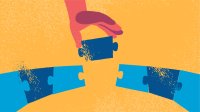Building a Bridge to a Place of Belonging
At a school in Norway, a program connects Norwegians and immigrants for pizza and games—with benefits for both groups.
Your content has been saved!
Go to My Saved Content.In recent years, Norway has seen an influx of refugees landing on its shores, people from all walks of life looking for a safe haven. One such haven is the school system—once granted legal residency, young immigrants have the right to attend school like all Norwegians.
On the surface this may sound straightforward, but in addition to dealing with the trauma of their journey, moving to a new country, and adapting to a new culture, they have to navigate a school system very different from what they’re used to—all while learning a new language.
Some students come with their entire families, others arrive alone. One can hardly imagine being a young adult who has to cope with all the things that come with such a situation. Most of all, they want to feel they belong. It’s for this reason that I started a program called the Bridge.
Building the Bridge
Recently I completed a master’s degree in multicultural and international education. The degree gave me the knowledge to take the step to start something new—I wanted to do something that could be fruitful and be my own. It was at this point I came up with the idea of the program.
I often witness foreign students struggling with the pressures of everyday life, from having two or three jobs while in school to working to get the grades they want. The biggest issue, though, is feeling alone in a new country.
So the purpose of the Bridge is to help these newcomers come into contact with Norwegians, and through this process learn to speak Norwegian. The Norwegian students, on the other hand, get to meet people who come from very different countries, cultures, and journeys than themselves—all of which contributes to a better school environment.
Initially my focus was on the students who are not Norwegian, but one day I received a note from a young Norwegian student asking to join since he had no friends. That’s when I realized that my program benefited more than my target group.
The Foundation of the Bridge
The Bridge is made up of around 80 students. We all meet once a month to connect, forming groups of four students each who will then meet at least twice during the following month on their own, preferably during lunch. Throughout the year everyone will meet each other through these groups, resulting in always having someone to say hi to in the school hallways.
The strength of the program lies in the students themselves. I deliberately choose four final-year students as team leaders—they are responsible for making up the social groups and helping at the larger gatherings, and they are given a special award on graduation day. For me it’s also important to make these students visible and an inspiration to others to complete school.
When the whole group meets, the room is usually full of excitement and anticipation about finding out who will be grouped with who. Sometimes we serve cake or pizza. (A Bridge student once came into my class to tell me that he couldn’t sleep the night before—because he was looking forward to the pizza. This comment went straight to my heart because something like pizza means nothing to young people in general, but when you live alone and work in addition to going to school, it takes on a whole new meaning.)
The meetings students have on their own are really up to them, but the big monthly gatherings with me might include playing games, watching a film together, or sitting with interview-type questions to get to know each other more deeply. A number of the non-Norwegian students live alone, so for them this kind of get-together is important.
The Keystone
The Bridge Program creates a relaxing space for students, a place for them to connect. It takes place in the real world and on the internet with a Facebook group. It’s open for anyone who wants to join. I saw that not only refugee and exchange students had a need to connect, but also the Norwegian students who feel alone and find it difficult to connect with others.
The students are very much involved in the way the program evolves. At the end of the year I get them to evaluate it and suggest ways to improve it. Doing this gives them ownership and a sense of belonging. One thing they all agreed upon was that they want more meetings of the whole group, which I welcome very much.
The Future of the Bridge
The underlying aim of the Bridge is for students to connect. At the same time, it helps to break down prejudice and assumptions students may have about people who come from different places. It doesn’t always have to be about the minority adapting—it’s about the majority too, contributing to a better intercultural understanding. Today students are under enormous pressures to fit in, do well, etc., and my hope is that this program can ease some of these pressures.
